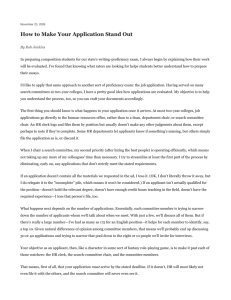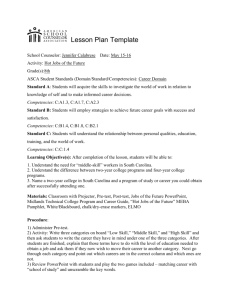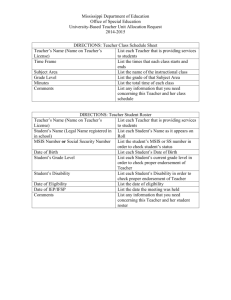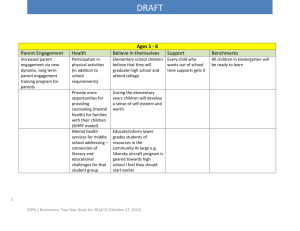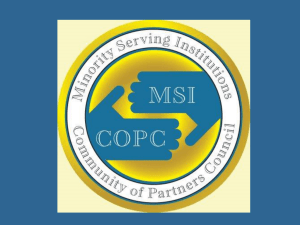On Their Own Terms: Two-Year Minority Serving Institutions
advertisement
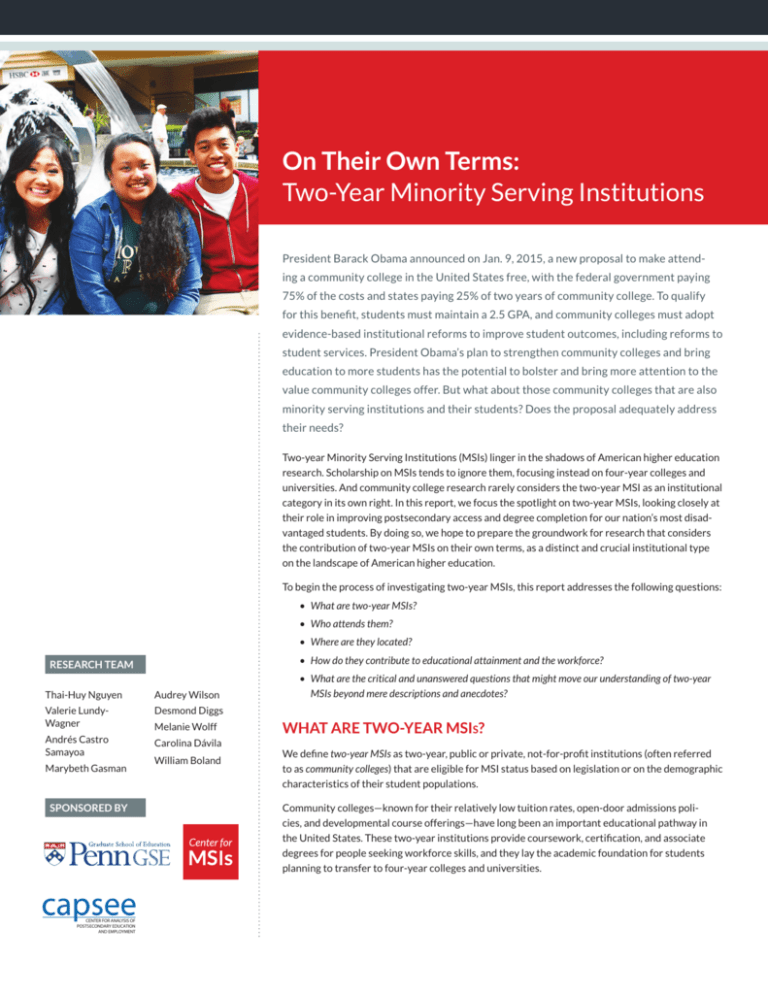
On Their Own Terms: Two-Year Minority Serving Institutions President Barack Obama announced on Jan. 9, 2015, a new proposal to make attending a community college in the United States free, with the federal government paying 75% of the costs and states paying 25% of two years of community college. To qualify for this benefit, students must maintain a 2.5 GPA, and community colleges must adopt evidence-based institutional reforms to improve student outcomes, including reforms to student services. President Obama’s plan to strengthen community colleges and bring education to more students has the potential to bolster and bring more attention to the value community colleges offer. But what about those community colleges that are also minority serving institutions and their students? Does the proposal adequately address their needs? Two-year Minority Serving Institutions (MSIs) linger in the shadows of American higher education research. Scholarship on MSIs tends to ignore them, focusing instead on four-year colleges and universities. And community college research rarely considers the two-year MSI as an institutional category in its own right. In this report, we focus the spotlight on two-year MSIs, looking closely at their role in improving postsecondary access and degree completion for our nation’s most disadvantaged students. By doing so, we hope to prepare the groundwork for research that considers the contribution of two-year MSIs on their own terms, as a distinct and crucial institutional type on the landscape of American higher education. To begin the process of investigating two-year MSIs, this report addresses the following questions: • What are two-year MSIs? • Who attends them? • Where are they located? • How do they contribute to educational attainment and the workforce? RESEARCH TEAM Thai-Huy Nguyen Audrey Wilson Valerie LundyWagner Desmond Diggs Andrés Castro Samayoa Carolina Dávila Marybeth Gasman SPONSORED BY Melanie Wolff William Boland • What are the critical and unanswered questions that might move our understanding of two-year MSIs beyond mere descriptions and anecdotes? WHAT ARE TWO-YEAR MSIs? We define two-year MSIs as two-year, public or private, not-for-profit institutions (often referred to as community colleges) that are eligible for MSI status based on legislation or on the demographic characteristics of their student populations. Community colleges—known for their relatively low tuition rates, open-door admissions policies, and developmental course offerings—have long been an important educational pathway in the United States. These two-year institutions provide coursework, certification, and associate degrees for people seeking workforce skills, and they lay the academic foundation for students planning to transfer to four-year colleges and universities. ON THEIR OWN TERMS: TWO-YEAR MINORITY SERVING INSTITUTIONS MSIs provide postsecondary access to ethnic/racial minorities and low-income populations (Gasman, Baez, & Turner, 2008; Conrad & Gasman, 2015). Minority Serving Institution is actually an umbrella term covering federally designated institutional types noted in this report—Historically Black Colleges and Universities (HBCUs); Asian American and Native American Pacific Islander Serving Institutions (AANAPISIs); Hispanic Serving Institutions (HSIs); and Tribal Colleges and Universities (TCUs).1 Each type is eligible for the federal MSI designation and access to federal funds based on different criteria, as shown in Table 1. HBCUs and TCUs are designated as MSIs primarily by virtue of their historic mission to serve their communities and our federal government’s commitment to tribal autonomy, respectively. HSIs and AANAPISIs are required to have at least 25 and 10 percent, respectively, of their undergraduate enrollment composed of full-time or equivalent (FTE) students from their target populations, as well as enroll qualified Pell grant recipients.2 In some cases, institutional resources (e.g., expenditures and revenues) are included as a component of MSI eligibility (SEE TABLE 1). There are 248 two-year institutions eligible for MSI designation; these institutions constitute 46 percent of all MSIs and 22 percent of the 1,132 community colleges nationwide (American Association of Community Colleges, 2014; National Center for Education Statistics [NCES], 2012). According to the Institute for Higher Education Policy, two-year MSIs are less resourced than both their four-year MSI and non-MSI community college counterparts, and their expenditures per student on student services and academic and institutional support for underserved students are also lower (Cunningham, Park, & Engle, 2014).3 In other words, it appears that the postsecondary institutions tasked with educating students with some of the biggest needs are given the fewest resources. Table 1 OVERVIEW OF MSI ELIGIBILITY % That Are 2-Year Colleges a Needy/Low-Income Institutional Resources AANAPISIs 55% ✘ ✘ ✘ HSIs 54% ✘ ✘ ✘ HBCUs 12% ✘ TCUs 67% ✘ Legislative MSI Designation Ethnic/Racial ELIGIBILITY REQUIREMENTSb ✘ SOURCE: NATIONAL CENTER FOR EDUCATION STATISTICS (2012) a The percentage of two-year colleges represented within each MSI designation. For example, 55 percent of AANAPISIs are two-year institutions. b MSI eligibility requirements for each designation were established with different legislative, demographic, and institutional resource requirements. According to the U.S. Department of Education, there are seven MSI types, three of which are not included in this report: Alaska Native and Native Hawaiian Serving Institutions, Predominantly Black Institutions, and Native American-Serving Nontribal Institutions. We focus on the four mentioned in this report because there exists far greater research and data on their status and performance. 1 2 See Minority Serving Institutions: Educating All Students (Gasman & Conrad, 2013) for more information on MSIs. The report can be retrieved from www2.gse.upenn.edu/cmsi. Institutions designated as AANAPISIs and HSIs must present evidence of fewer institutional resources than a set of comparable peer institutions in order to access some federal MSI funds. This report only includes this measure where noted. 3 2 ON THEIR OWN TERMS: TWO-YEAR MINORITY SERVING INSTITUTIONS WHO ATTENDS TWO-YEAR MSIs? Of all students enrolled in U.S. colleges and universities, significant portions of them attend twoyear MSIs. These institutions enroll 30 percent of Hispanics/Latinos, 26 percent of Pacific Islanders, 22 percent of Asian Americans, 12 percent of American Indians, 10 percent of Blacks/African Americans, and 6 percent of Whites (SEE FIGURE 1). Figure 1 PERCENTAGE OF ALL STUDENTS ENROLLED IN TWO-YEAR MSIs, BY RACE/ETHNICITY: 2012 HISPANICS/LATINOS PACIFIC ISLANDERS ASIAN AMERICANS AMERICAN INDIANS BLACKS/AFRICAN AMERICANS WHITES 0% 5% 10% 15% 20% 25% 30% SOURCE: NATIONAL CENTER FOR EDUCATION STATISTICS (2012) Notes: Data is based on 12-month unduplicated headcount of the undergraduate population. African American, Asian American, Pacific Islander, Latina/o, and American Indian students are all more likely to attend community colleges than four-year institutions (Admon, 2005). And two-year MSIs enroll a disproportionately higher portion of their focal populations than do other two-year institutions (SEE TABLE 2). For example, the 170 two-year HSIs account for only 7 percent of all two-year institutions. Despite this modest proportion, they enroll 28 percent of all Hispanics in two-year colleges and confer degrees to 45 percent of all Hispanics completing their degrees at two-year institutions. Table 2 CONTRIBUTIONS OF TWO-YEAR0MSIs, 20125 INSTITUTIONS 10 15 20 ENROLLMENT 25 30 DEGREES # of Institutions % of All Two-Year Institutions # of Focal Population % of Focal Population # of Focal Population % of Focal Population AANAPISIs 81 3% 199,938 16% 19,670 40% HBCUs 13 1% 24,191 1% 3,809 3% HSIs 170 7% 844,355 28% 67,602 45% TCUs 20 1% 4,742 3% 537 5% Two-Year MSIs SOURCE: NATIONAL CENTER FOR EDUCATION STATISTICS, INTEGRATED POSTSECONDARY EDUCATION DATA SYSTEM (IPEDS) 12-MONTH ENROLLMENT AND COMPLETION SURVEYS, 2011–12 Notes: The total number of two-year MSIs is 246, of which there are 38 institutions with more than one designation (e.g., both HSI and AANAPISI). This count is based on a combination of sources including those from the U.S. Department of Education and those from policy and advocacy organizations. Please refer to the Center for MSIs website for further details. 3 ON THEIR OWN TERMS: TWO-YEAR MINORITY SERVING INSTITUTIONS Two-year MSIs play a significant role in American Indian/Alaska Native, Hispanic, and Pacific Islander undergraduates’ postsecondary access compared with other two-year colleges (SEE TABLE 3). In fact, Native Hawaiians and other Pacific Islanders are twice as likely to be enrolled at two-year MSIs than at two-year non-MSIs, while American Indians or Alaska Natives are five times more likely to attend two-year MSIs. Asian4 and Hispanic enrollment make up 7 percent and 27 percent of the two-year MSI student population, respectively. Black student enrollment is similar in two-year institutions regardless of MSI status, whereas White students represent the most populous group across both types of institutions. Asian Black/African American Hispanic/Latino Native Hawaiian or Other Pacific Islander White Two or More Races Race/ethnicity Nonresident Alien TWO-YEAR ENROLLMENT DISTRIBUTION BY RACE/ETHNICITY AND MSI STATUS, 2012 American Indian or Alaska Native Table 3 2-YEAR MSIs 6% 7% 20% 27% 2% 31% 2% 4% 1% 2-YEAR NON-MSIs 1% 2% 21% 13% 0% 55% 2% 5% 1% MSI Status SOURCE: U.S. DEPARTMENT OF EDUCATION, NATIONAL CENTER FOR EDUCATION STATISTICS, INTEGRATED POSTSECONDARY EDUCATION DATA SYSTEM (IPEDS) 12-MONTH ENROLLMENT AND COMPLETION SURVEYS, 2011-12 Figure 2 TWO-YEAR AANAPISI ENROLLMENT BY RACE/ETHNICITY, 2012 1% 24% 23% 12% 11% 29% ■A sian American, American Indian, Pacific Islander ■A merican Indian and Native Alaskan Here we provide a summary of student enrollment based on MSI designation: TWO-YEAR AANAPISIS. Asian American, Pacific Islander and Native Hawaiian students represent 24 percent of the two-year Asian American, Native American and Pacific Islander Serving Institutions (AANAPISIs) population (U.S. Census Bureau, 2012).5 Despite this relatively high representation of AAPIs, these institutions are quite diverse. In fact, the undergraduate enrollment in two-year AANAPISIs is approximately 23 percent Hispanic, 11 percent African American, 29 percent White, and 1 percent American Indian and Native Alaskan (SEE FIGURE 2). Sixty-two percent of the two-year AANAPISI student body is enrolled part-time, a rate that is almost twice that of non-MSI two-year institutions (34 percent). Moreover, two-year AANAPISIs have an average part-time retention rate of 43 percent, representing a slight advantage over non-MSI two-year institutions. This suggests that, at the very least, AANAPISIs are retaining part-time students as well as their non-MSI counterparts, despite having a larger part-time student population.6 ■H ispanic/Latino ■B lack/African American ■ White ■O ther We use the terms “Asian” and “Asian American” deliberately throughout based on the specific data source used. 4 5 Disaggregated, the 24 percent is made up of 16 percent Asians and 8 percent Native Hawaiians or other Pacific Islanders. Data are taken from the Integrated Postsecondary Education Data System. Part-time retention rate is defined as: “the percent of the [fall part-time cohort from the prior year minus exclusions from the fall part-time cohort] that re-enrolled at the institution as either full- or part-time in the current year.” This definition is used consistently throughout this report. 6 4 ON THEIR OWN TERMS: TWO-YEAR MINORITY SERVING INSTITUTIONS TWO-YEAR HBCUs. The student body composition at two-year HBCUs includes 81 percent Black and 10 percent White students (SEE FIGURE 3). Two-year HBCUs attract more full-time students (85 percent) than other two-year MSIs and non-MSI two-year colleges (66 percent), where among the latter only 21 percent of Black students are full-time, on average. The average full-time retention rate at two-year HBCUs is 52 percent, almost 10 percentage points lower than at non-MSI two-year institutions. The part-time retention rate for two-year HBCUs is 42 percent. TWO-YEAR HSIs. On average, just less than half of their enrollment (45 percent) is Hispanic/ Latino, with White, Black, and Asian enrollment at approximately 30 percent, 10 percent, and 8 percent, respectively (SEE FIGURE 4). The part-time enrollment rate at two-year HSIs is 64 percent, and the retention rate is 44 percent. Similar to AANAPISIs, two-year HSIs have a larger share of part-time students and are retaining them at a rate similar to their non-MSI counterparts. TWO-YEAR TCUs. The population at two-year TCUs is largely American Indian (80 percent); 16 percent of students at TCUs are White (SEE FIGURE 5). On average, 43 percent of the student population is enrolled part-time. The overall retention rate is 36 percent. Figure 3 TWO-YEAR HBCU ENROLLMENT BY RACE/ETHNICITY, 2012 Figure 4 TWO-YEAR HSI ENROLLMENT BY RACE/ETHNICITY, 2012 Figure 5 0% 2% TWO-YEAR TCU ENROLLMENT BY RACE/ETHNICITY, 2012 1% 1% 1% 10% 7% 7% 8% 1% 30% 16% 45% 81% 80% 10% ■A sian American, American Indian, Pacific Islander ■H ispanic/Latino ■B lack/African American ■ White ■O ther ■A sian American, American Indian, Pacific Islander ■H ispanic/Latino ■B lack/African American ■ White ■O ther ■N ative American ■A sian American, American Indian, Pacific Islander ■ Black/African American ■ White ■O ther ■H ispanic/Latino WHERE ARE TWO-YEAR MSIs LOCATED? Many two-year MSIs, like their four-year counterparts, are located near the ethnic and racial communities they primarily serve (Conrad & Gasman, 2015; Gasman, Baez, & Turner, 2008). For instance, the greatest portion of two-year HSIs (42 percent) are located in the Southwest (IPEDS, 2012)—which has seen the most rapid growth in the Hispanic population in the United States over the past 30 years (U.S. Census Bureau, 2012). The number of two-year AANAPISIs is also increasing in California and New York, where there are growing communities of Asian Americans and Pacific Islanders. Growth is especially prevalent among those AAPI ethnic groups that have been traditionally underrepresented in postsecondary education, such as Vietnamese, Laotian, and Taiwanese. Two-year HBCUs and TCUs are found in regions that have historically had a significant presence of their focal ethnic and racial groups, and where access to four-year institutions has remained limited, in part due to acutely underfunded school systems and concomitant poor secondary school achievement (Aud et al., 2012) (SEE FIGURE 6). 5 ON THEIR OWN TERMS: TWO-YEAR MINORITY SERVING INSTITUTIONS Figure 6 TWO-YEAR MSIs & PERCENTAGE OF PELL GRANT RECIPIENTS AANAPISIs HBCUs TCUs HSIs Percentage of Students Receiving Pell Grants 8%-30% 31%-60% 61%-80% 81%-100% 2012 Median Household Income ■ More than $82,000 ■ $68,001 to $82,000 ■ $53,001 to $68,000 ■ $39,001 to $53,000 (US median: $50,157) ■ $24,001 to $39,000 ■ $24,000 or less PUERTO RICO ■ No households SOURCE: IPEDS & ESRI, FALL 2012 Table 4 PROPORTION OF PELL GRANT RECIPIENTS BY MSI STATUS MSI Status Full-Time, First-Time Undergraduates Receiving Pell Grants Two-Year Non-MSIs 69% Two-Year MSIs 65% AANAPISIs 54% HBCUs 79% HSIs 61% TCUs 81% Many MSIs are located in low-income areas and enroll a significant number of students receiving federal Pell grants. In fact, two-year HBCUs and TCUs are located in noticeably lower income areas and enroll a large population of students receiving Pell grants (SEE TABLE 4). Two-year HSIs and AANAPISIs enroll a smaller proportion of Pell grant recipients and are located in relatively higher income areas. Two-year MSIs situated in relatively higher income areas may represent race-related migration patterns and access (or lack thereof) to housing (Cunningham, Park, & Engle, 2014). In fact, both California’s and New York’s economic conditions have increased the cost of living significantly, with virtually no corresponding improvement in state financial aid available to low-income students (Baum & Ma, 2013). Such conditions may constrain student choice—both in terms of whether people pursue postsecondary education and, if they do, the type of institution they choose—making two-year MSIs an affordable option. 6 ON THEIR OWN TERMS: TWO-YEAR MINORITY SERVING INSTITUTIONS For example, in Northern California’s Santa Clara County, some two-year MSIs are located in regions where the median household income is well above the national average, yet almost a quarter of all students receive Pell grants (SEE FIGURE 7). Notably, almost half of the incoming first-year class (44 percent) at Gavilan College receives Pell grants (NCES, 2012). This school’s institutional profile is akin to other MSIs: Over half of its students belong to a racial or ethnic minority, about half are 25 or older, and graduation rates are below 30 percent. Yet, Gavilan is situated in an area of the county where household income surpasses the national average by over $30,000. In a region that has witnessed strong economic growth, two-year MSIs such as Gavilan represent gateways to higher education for those unfavorably affected by the widening of the income gap. Figure 7 INSTITUTIONS OF HIGHER EDUCATION IN SANTA CLARA COUNTY, CALIFORNIA 2012 Median Household Income Stanford University ■ More than $82,001 CSU-East Bay Mission College Foothill College ■ $68,001 to $82,000 San Jose State University ■ $53,001 to $68,000 Santa Clara University ■ $39,001 to $53,000 De Anza College San Jose City College ■ $24,001 to $39,000 Evergreen Valley College ■ $16,074 to $24,000 West Valley College N W E S Percentage of Students Receiving Pell Grants 19%-26% Gavilan College 27%-39% 40%-58% 2-year MSIs 4-year non-MSIs 59%-77% 4-year MSIs 0.09 0.045 0 0.09 Decimal Degrees 7 ON THEIR OWN TERMS: TWO-YEAR MINORITY SERVING INSTITUTIONS Figure 8 INSTITUTIONS OF HIGHER EDUCATION IN THURSTON COUNTY, NEBRASKA 2012 Median Household Income ■ $33,380 to $39,000 ■ $39,001 to $53,000 Little Priest Tribal College ■ $53,001 to $68,000 N W E S Percentage of Students Receiving Pell Grants Nebraska Indian Community College 51% 90% 0.09 0.045 0 0.09 Decimal Degrees Some two-year MSIs are located in regions where much of the surrounding community lives in poverty. Consider Thurston County, Nebraska, home to a pair of two-year MSIs. Little Priest Tribal College, with almost all of its students receiving Pell grants, is an example of a two-year MSI charged with educating students in an area experiencing persistent economic hardship; the average income is below the national average by almost $20,000 (U.S. Census Bureau, 2012). (SEE FIGURE 8.) Just 11 miles southeast is Nebraska Indian Community College, where only about half of the students receive Pell grants. Thus in even the most economically depressed areas, there are differentials in the low-income population attending two-year MSIs (as measured by percentage of students receiving the federal Pell grant). Below is a summary of each MSI designation by geography and sector. TWO-YEAR AANAPISIs. The 145 two-year AANAPISIs are located across 15 states and U.S. territories (NCES, 2012). Many are located in California (43), the state with the largest Asian population (U.S. Census Bureau, 2012), with others also clustered in Illinois (5), New York (5), Hawaii (5), Washington State (5), and Texas (4). Two AANAPISIs are private not-for-profit institutions. TWO-YEAR HBCUs. Of the 105 HBCUs, 13 (or 12 percent) are community colleges (NCES, 2012). As with most HBCUs, these institutions are located in the South: Alabama (6), Arkansas (1), Louisiana (1), Mississippi (2), South Carolina (2), and Texas (1). Two two-year HBCUs are private, not-for-profit institutions. TWO-YEAR HSIs. Two-year institutions make up 54 percent (171) of all HSIs (315) (NCES, 2012). The majority of two-year HSIs are located in California (77), Texas (30), and New Mexico (15), where Hispanics/Latinos make up 38 percent, 38 percent, and 47 percent of the state population, respectively.7 Seven HSIs are private, not-for-profit institutions. At 99 percent, Puerto Rico maintains the largest proportion of a Hispanic population within a U.S. state or territory (U.S. Census Bureau, 2012). Despite the fact that there are 49 HSIs in Puerto Rico, only three are community colleges. 7 8 ON THEIR OWN TERMS: TWO-YEAR MINORITY SERVING INSTITUTIONS TWO-YEAR TCUs. Among the 34 TCUs, 21 (or 62 percent) are two-year institutions (NCES, 2012). Historically, TCUs were founded as community colleges; today, there are 13 four-year TCUs, some of which were formerly two-year institutions. TCUs exist primarily on or near reservations in the northern Midwest, such as Wisconsin and the Rocky Mountain states, including Montana and South Dakota. Three TCUs are private, not-for-profit institutions. HOW DO TWO-YEAR MSIs CONTRIBUTE TO EDUCATIONAL ATTAINMENT AND THE WORKFORCE? Community colleges play an important role in postsecondary education and workforce preparation. But four prominent issues in the community college literature—developmental education, postsecondary credential receipt, transfer, and labor market outcomes—are particularly relevant for two-year MSIs. Developmental Education Many low-income and minority populations live in communities with under-resourced primary and secondary schools, leaving a significant number of students underprepared for college-level work. In an effort to address this, two-year colleges offer not-for-degree-credit courses to provide academically underprepared students with the skills needed to succeed in college-level coursework. Approximately 70 percent of students across all two-year colleges are referred to at least one developmental or remedial course (Bailey, Jeong, & Cho, 2008). Further, nearly 34 percent of Latina/os and nearly half of all African Americans earning bachelor’s degrees were once enrolled in a developmental course (Attewell, Lavin, Domina, & Levey, 2006), suggesting that efforts to decrease racial disparities in postsecondary educational attainment must consider two-year MSIs as critical partners. Despite the prevalence of developmental education overall and in two-year colleges specifically, its effect on student achievement has been unclear (Jaggars & Stacey, 2014). In fact, less than 30 percent of two-year college students who take a developmental education course go on to earn a degree within eight years, and many drop out before even completing the developmental sequence required for college-level courses. Moreover, many states do not disaggregate remediation data by ethnicity and race (Parker, 2011), preventing a complete understanding of the role MSIs (and non-MSIs) play in supporting minority readiness for college-level work; this may have important implications for financial aid policy, given the high monetary and nonmonetary costs associated with developmental education. Postsecondary Credential Receipt Two-year MSIs play an important role in sub-baccalaureate credential receipt, especially for racial/ ethnic minority students. In fact, two-year MSIs enroll 20 percent of minorities and graduate 29 percent of minority associate degree recipients annually (NCES, 2012). Like their four-year counterparts, two-year MSIs play a disproportionate role in minority science, technology, engineering, and mathematics (STEM) credential attainment. In fact, 4 percent of the 1,190 two-year institutions qualifying demographically as MSIs in 2008–9 granted 6 percent of minority STEM associate degrees and 9 percent of STEM sub-baccalaureate certificates. Two-year MSIs contributed to 21 percent of Asian, 18 percent of Latina/o, 14 percent of Black, and 4 percent of American Indian STEM credentials that same year (Stage, John, Lundy-Wagner, & Conway, 2013). Transfer Transfer rates for students attending community colleges and pursuing four-year degrees are disappointingly low for all students, especially minority students. In fact, work on California’s community college system suggests that 75 percent of Black and 80 percent of Latina/o students neither complete a certificate or degree nor transfer to a four-year college in the six years after initial enrollment (Moore & Shulock, 2010). 9 ON THEIR OWN TERMS: TWO-YEAR MINORITY SERVING INSTITUTIONS Although research on MSIs and transfer is limited, there is evidence that minorities intending to transfer to four-year institutions are more likely to enroll in a two-year MSI (e.g., Núñez, Sparks, & Hernandez, 2011). Nearly 44 percent of all science and engineering bachelor’s and master’s degree recipients attend a community college. The corresponding rates for minority groups are as follows: 51 percent of Latina/os, 44 percent of American Indians/Alaska Natives, 44 percent of Blacks, and 40 percent of Asians/Pacific Islanders. These data suggest that MSIs are indeed playing a critical role in promoting minority transitions from two- to four-year institutions, especially in STEM fields. Labor Market Outcomes Two-year colleges provide individuals with the ability to improve their opportunities in the workforce through relevant coursework, sub-baccalaureate certificates, and associate degrees. Although earning occupational certificates does not always significantly change short-term wages (Xu & Trimble, 2014), earning an associate degree does, on average, lead to a significant increase in wages (e.g., Belfield & Bailey, 2011). There is also some research evidence on the impact of developmental education on workforce opportunities and salary (e.g., Hodara & Xu, 2014; Martorell & McFarlin, 2011), although the extent to which MSI matriculation or credential receipt influences these benefits has not been studied. EXAMPLES OF TITLE III AND TITLE IV FEDERAL MSI GRANT-FUNDED PROJECTS TYPE INSTITUTION FUNDING USED TO: AANAPISI Seattle Community Colleges Increase student English as Second Language transition rates to college courses AANAPISI De Anza College Develop Asian/Pacific Islander-focused academic programs with integrated student support services AANAPISI Guam Community College Build the Learning Resource Center AANAPISI Mission College Improve transfer rates to four-year STEM programs HBCU Bishop State Community College – Main Campus Enhance the integration of new instructional technology for academic support services HBCU Gadsden State Community College Improve faculty and staff professional development HBCU J.F. Drake State Community College Enhance student services, including 24-hour access to admissions data, financial literacy, advising and tutoring HBCU Lawson State Community College Upgrade media communications curriculum to focus on careers such as web designers and media researchers HSI Hudson County Community College Increase the pace of progress through developmental courses with a Foundational Learning Institute HSI West Hills College Expand educational offerings for instruction and support by training faculty in effective distance course development and delivery HSI Santa Monica College Increase institutional capacity to support underprepared career-technical educational students HSI Luna Community College Create a clearer pathway to success in high-demand programs TCU Southwestern Indian Polytechnic Institute Foundation Update current distance education and blended course offerings via the expansion of online and videoconferencing infrastructure TCU Fort Peck Community College Develop integrated planning and data management in order to use data more effectively TCU Nebraska Indian Community College Strengthen curriculum delivery and support, and improve student information systems TCU Cankdeska Cikana Community College Upgrade the technology/fine arts center with new computers, a hardware repair lab, a climate-controlled server room, staff offices and two fine arts classrooms These 125 institutions were eligible for the federal MSI designation, obtained the designation, applied for federal MSI funds, and were subsequently awarded MSI funds. Institutions may be eligible for and not obtain the MSI designation, may obtain the MSI designation and not apply for MSI funds, or may apply for but not be awarded MSI funds. 8 10 ON THEIR OWN TERMS: TWO-YEAR MINORITY SERVING INSTITUTIONS WHAT ARE THE CRITICAL AND UNANSWERED QUESTIONS THAT MIGHT MOVE OUR UNDERSTANDING OF TWO-YEAR MSIs BEYOND MERE DESCRIPTIONS AND ANECDOTES? To better understand the influence of two-year MSIs on postsecondary access, attainment, and labor market outcomes, we encourage researchers and policymakers to consider the following questions: •H ow does students’ knowledge of an institution’s MSI status, or lack thereof, shape their pathways to completion and transfer, if at all? •H ow do MSI eligibility criteria affect two-year enrollment and completion (i.e., credential receipt and transfer) by ethnicity and race in relevant geographic areas? How has this changed over time, if at all, for various groups? •W hat is the capacity of two-year MSIs to close educational attainment gaps by ethnicity and race? How do federal, state, and local policies influence two-year MSIs’ ability to decrease these gaps? • To what extent do two-year MSIs contribute to the economic conditions (including labor market outcomes) of their ethnic/racial minority and low-income students? How does access to the federal Pell grant influence outcomes? • How are federal MSI funds affecting gaps in educational attainment and economic stability for low-income and minority groups? What data, infrastructure, and policies are needed to evaluate this at the institutional and state levels? CONCLUSION Given the nation’s goals for higher education and its changing demographics, MSIs and community colleges are situated to become even more important. Community colleges that are MSIs are essential, in that they serve students who often face myriad academic, financial, political, and personal challenges. As a nation, we need to pay more attention to these under-resourced institutions and their students. In particular, we need more evidence on how students fare at these colleges and on programs and policies at two-year MSIs that are aimed at increasing retention and attainment among targeted students. Two-year MSIs are poised to support greater social mobility and economic stability for racial/ethnic minority and low-income students—but only if we invest in them in meaningful and effective ways. 11 ON THEIR OWN TERMS: TWO-YEAR MINORITY SERVING INSTITUTIONS REFERENCES Admon, N. (2005). Minority access to higher education and its social outcomes. Essays in Education, 14. American Association of Community Colleges. (2014). 2014 fact sheet. Retrieved from www.aacc.nche.edu/AboutCC/Pages/fastfactsfactsheet.aspx Attewell, P., Lavin, D., Domina, T., & Levey, T. (2006). New evidence on college remediation. Journal of Higher Education, 77(5), 886-924. Aud, S., Hussar, W., Johnson, F., Kena, G., Roth, E., Manning, E., Wang, X., & Zhang, J. (2012). The condition of education 2012 (NCES 2012-045). Washington, D.C.: U.S. Department of Education, National Center for Education Statistics. Retrieved from http://nces.ed.gov/pubsearch Bailey, T., Jeong, D.W., & Cho, S.W. (2008). Referral, enrollment, and completion in developmental education sequences in community colleges (CCRC Working Paper No. 15). New York, NY: Community College Research Center, Teachers College, Columbia University. Baum, S., & Ma, J. (2013). Trends in college pricing. New York, NY: The College Board. Retrieved from http://trends.collegeboard.org/sites/default/files/college-pricing-2013-full-report-140108.pdf Belfield, C. R., & Bailey, T. (2011). The benefits of attending community college: A review of the evidence. Community College Review, 39(1), 46–68. Conrad, C., & Gasman, M. (2015). Educating a Diverse Nation: Lessons from minority serving institutions. Cambridge, MA: Harvard University Press. Cunningham, A. F., Park, E., & Engle, J. (2014). Minority serving institutions: Doing more with less. Washington, D.C.: Institute of Higher Education Policy. Gasman, M., Baez, B., & Turner, C. S. (2008). Understanding minority serving institutions. New York, NY: State University of New York Press. Gasman, M., & Conrad, C. F. (2013). Minority serving institutions: Educating all students. Philadelphia, PA: Penn Center for Minority Serving Institutions, Graduate School of Education, University of Pennsylvania. Hodara, M., & Xu, D. (2014). Does developmental education improve labor market outcomes? Evidence from two states (CAPSEE Working Paper). New York, NY: Center for Analysis of Postsecondary Education and Employment. Jaggars, S. S., & Stacey, G. W. (2014). What we know about developmental education outcomes: Research overview. New York, NY: Community College Research Center, Teachers College, Columbia University. The research reported here was supported in part by the Institute of Education Sciences, U.S. Department of Education, through Grant R305C110011 to Teachers College, Columbia University. The opinions expressed are those of the authors and do not represent views of the Institute or the U.S. Department of Education. Martorell, P. & McFarlin, I., Jr. (2011). Help or hindrance? The effects of college remediation on academic and labor market outcomes. Review of Economics and Statistics, 93(2), 436–454. Moore, C., & Shulock, N. (2010). Divided we fail: Improving completion and closing racial gaps in California’s community colleges. Sacramento, CA: Institute for Higher Education Leadership & Policy. National Center for Education Statistics, Institute of Education Sciences (NCES), U.S. Department of Education. Integrated Postsecondary Education Data System (IPEDS); MSI enrollment rates component, [dataset] (2012). Núñez, A., Sparks, P. J., & Hernández, E. A. (2011). Latino access to community colleges and Hispanic-serving institutions: A national study. Journal of Hispanic Higher Education, 10(18), 18–40. Parker, T.L. (2011). The role of Minority serving institutions in redefining and improving developmental education. Atlanta, GA: Southern Education Foundation. Stage, F. K., John, G., Lundy-Wagner, V., & Conway, K. (2013). Minority serving community colleges and the production of STEM associate’s degrees. In R. T. Palmer & J. L. Wood (Eds.), Community colleges and STEM: Examining underrepresented racial and ethnic minorities (pp. 140–155). New York, NY: Routledge. U.S. Census Bureau. (2012, March). The Asian population 2010. Retrieved from www.census.gov/prod/ cen2010/briefs/c2010br-11.pdf Xu, D., & Trimble, M.J. (2014). What about certificates? Evidence of the labor market returns to non-degree community college awards in two states (CAPSEE Working Paper). New York, NY: Center for Analysis of Postsecondary Education and Employment. 12


